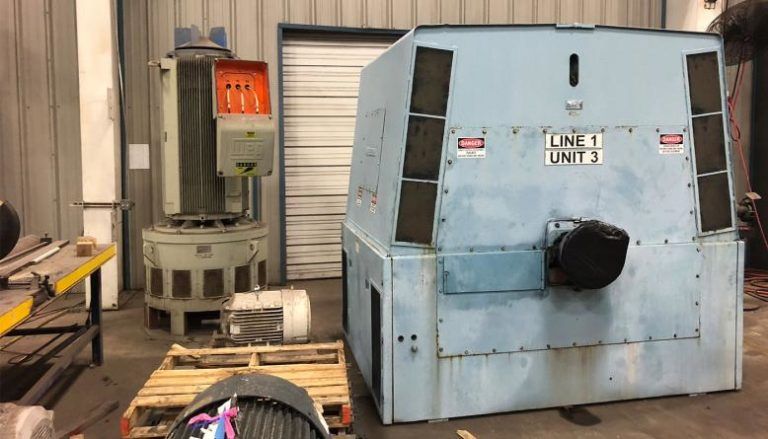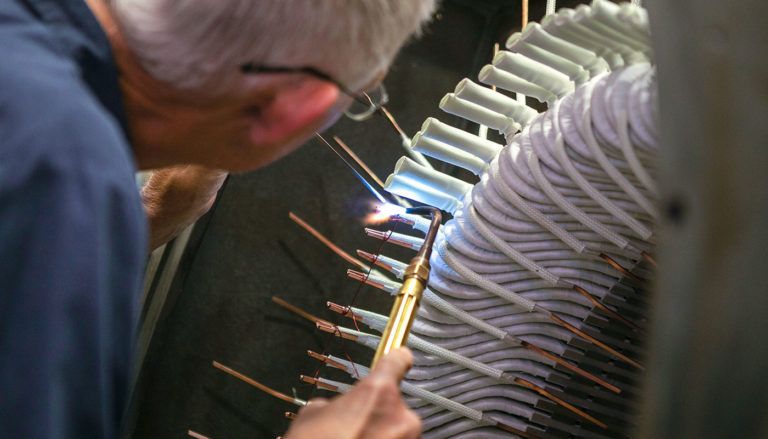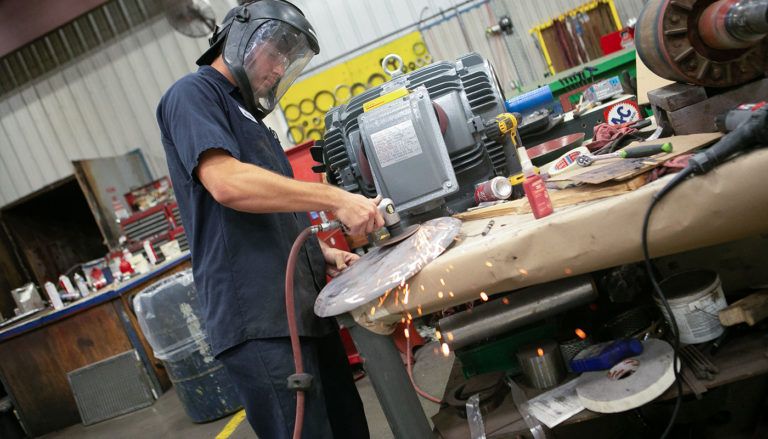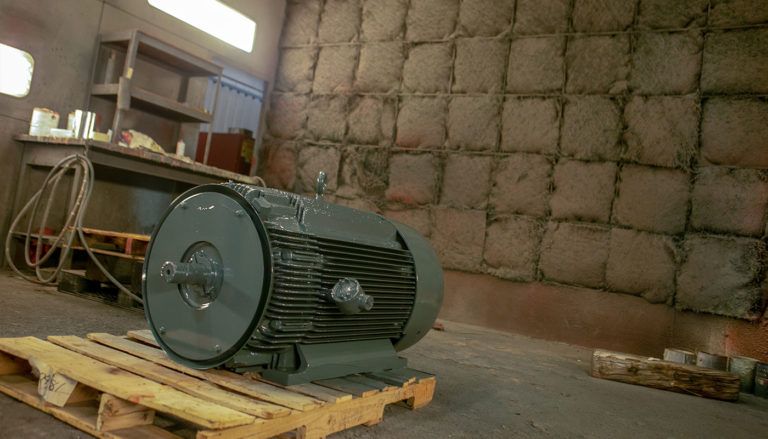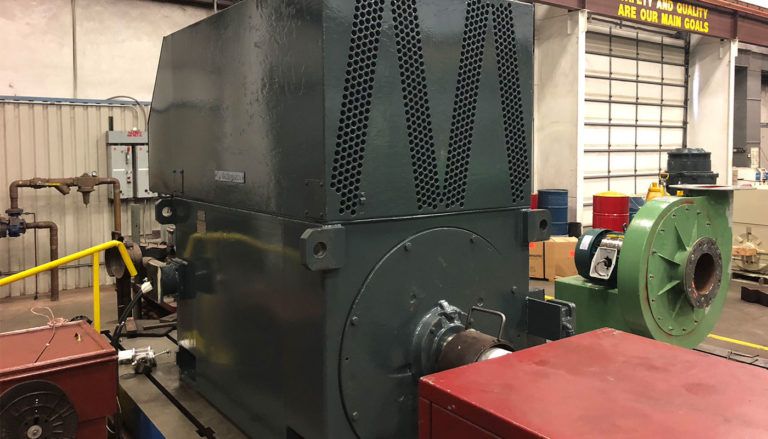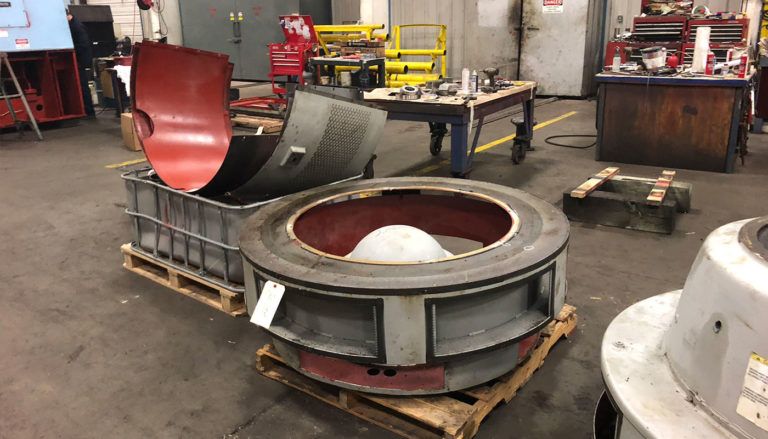Arrival Procedures
As your electric motor arrives at our facility, we take the utmost care of unloading and transporting your motor by using one of two 20 ton bridge cranes located here in our main bay area. All nameplate information is recorded onto a work order, and pictures are taken for quality assurance. The motor is then disassembled and tested for electrical or mechanical issues. Electrical test such as Meg, surge, and PI tests as well as mechanical tests such as MIC readings on endbells and bearings journals, shaft run-outs, bearing OD, and ID test are documented. After disassembly and testing procedures are performed, and the motor proves to be a rewind, it then goes to our controlled heat burn-off oven. If the windings are right, then the stator goes into the pressure wash area.
Washroom
In our pressure wash area, we use one of our two 7.5 ton bridge cranes to transport your motor safely. The motor is carefully cleaned and pressure washed to ensure maximum visibility. Eagle Electric Machinery uses a state-of-the-art oil/water separator that is environmentally safe.
Burn-Off Oven
All electric motors to be rewound are burned in a Stillman input controlled heat oven at 700 degrees Fahrenheit and, then the windings are removed before it enters our blast room.
Blast Room
Using our 18' x 16' x 20' Hoffman Steel-Shot Blast Room, your motor is blasted giving it a smoother surface using fine steel-shot instead of sand. The stator is then core tested to ensure lamination integrity before it goes to the rewind area.
MOTOR REWINDING PROCEDURE / WINDING ROOM
The motor rewinding procedure room is isolated from all of the workstations to ensure cross-contamination is minimal. We perform AC motor rewinds to 10,000 horsepower 6,900 volts, DC motor rewinds to 5,000 horsepower 750 volts, and generator rewinds to 5,000 kilowatts. Our insulation is rated for class H, and we use spike-resistant, class H wire standard on 460 volts. We also offer computerized winding redesigns up to 6,900 volts. The Baker AWA IV incorporates the most advanced capabilities ever provided in a field-portable instrument. This machine can determine if your winding coils have failed, are in the process of failing, or approved for continuous use. Once the coils are manufactured, they are installed into the stator and are then taken to our VPI (Vaccum Pressure Impregnation) Tank.
VPI Tanks
The Emprex Vacuum Pressure Impregnation System (VPI) is critical to the motor repair process. The VPI tank is a 9' x 9' tank that uses positive and negative pressure to ensure that the VRI 70 40 41 epoxy varnish surrounds and seals the new form coils that were installed in the winding room. Using our 20-ton bridge crane, we can safely lift and place your motor into position in the tank. This process takes place with electric motors having medium voltage and above. Lower voltage motors will receive their process in the varnish treatment tank. After processing that stator is then taken out and placed in the bake oven to cure the epoxy.
Bake Oven
Motors are baked in a Stillman 12' x 12' x 16' Control Heat Oven at 315 degrees Fahrenheit. After the baking process, your motor is ready for our work-in-progress and assembly area.
Assembly Area
One part of the work-in-progress area is our 15,000 lbs capacity Undercutter that undercuts DC commutators. We also have a 40-foot bed, 10,000 lbs capacity, computerized balancing machine to balance rotors and armatures. Motors are assembled with careful note taken using pictures for the disassembly process. If required, we will provide your motor with a UL recertification.
Paint Booth
In this area, your motor will enter our 20' x 20' x 15' paint booth to be painted with epoxy varnish before being shipped to you or Tulco Industrial Storage.
Testing Station
Upon completion of repair, each motor is tested. Your motor will go to our 10' x 10' T-base for testing. We use a Phoenix 1,500 kva Motor Test Set to test run the motor at full voltage, no load, which is standard. This system is capable of testing 3 phase induction motors, DC motors, synchronous motors, and wound rotor motors. Upon request, your motor can be dyno-tested full load up to 2,700 horsepower using our Power Test Water Break Diameter System. Voltage, amps, vibration readings, bearing, and winding temperatures are monitored and documented as well as infrared pictures to capture any excess heating. This extensive testing ensures that your motor is working at full functional capacity.

